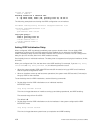
!
S1(conf)#interface TenGigabitEthernet 2/3
S1(conf-if-te-2/3)#ip vrf forwarding VRF-3
S1(conf-if-te-2/3)#ip address 20.1.1.5/24
S1(conf-if-te-2/3)#vrrp-group 15
% Info: The VRID used by the VRRP group 15 in VRF 3 will be 243.
S1(conf-if-te-2/3-vrid-105)#priority 255
S1(conf-if-te-2/3-vrid-105)#virtual-address 20.1.1.5
S1(conf-if-te-2/3)#no shutdown
Example of Configuring VRRP in a VRF on Switch-2 (Non-VLAN Configuration)
Switch-2
S2(conf)#ip vrf default-vrf 0
!
S2(conf)#ip vrf VRF-1 1
!
S2(conf)#ip vrf VRF-2 2
!
S2(conf)#ip vrf VRF-3 3
!
S2(conf)#interface TenGigabitEthernet 2/1
S2(conf-if-te-2/1)#ip vrf forwarding VRF-1
S2(conf-if-te-2/1)#ip address 10.10.1.2/24
S2(conf-if-te-2/1)#vrrp-group 11
% Info: The VRID used by the VRRP group 11 in VRF 1 will be 177.
S2(conf-if-te-2/1-vrid-101)#priority 255
S2(conf-if-te-2/1-vrid-101)#virtual-address 10.10.1.2
S2(conf-if-te-2/1)#no shutdown
!
S2(conf)#interface TenGigabitEthernet 2/2
S2(conf-if-te-2/2)#ip vrf forwarding VRF-2
S2(conf-if-te-2/2)#ip address 10.10.1.2/24
S2(conf-if-te-2/2)#vrrp-group 11
% Info: The VRID used by the VRRP group 11 in VRF 2 will be 178.
S2(conf-if-te-2/2-vrid-101)#priority 255
S2(conf-if-te-2/2-vrid-101)#virtual-address 10.10.1.2
S2(conf-if-te-2/2)#no shutdown
!
S2(conf)#interface TenigabitEthernet 2/3
S2(conf-if-te-2/3)#ip vrf forwarding VRF-3
S2(conf-if-te-2/3)#ip address 20.1.1.6/24
S2(conf-if-te-2/3)#vrrp-group 15
% Info: The VRID used by the VRRP group 15 in VRF 3 will be 243.
S2(conf-if-te-2/3-vrid-105)#priority 100
S2(conf-if-te-2/3-vrid-105)#virtual-address 20.1.1.5
S2(conf-if-te-2/3)#no shutdown
VLAN Scenario
In another scenario, to connect to the LAN, VRF-1, VRF-2, and VRF-3 use a single physical interface with
multiple tagged VLANs (instead of separate physical interfaces).
In this case, you configure three VLANs: VLAN-100, VLAN-200, and VLAN-300. Each VLAN is a member
of one VRF. A physical interface (tengigabitethernet 0/1) attaches to the LAN and is configured as a
tagged interface in VLAN-100, VLAN-200, and VLAN-300. The rest of this example is similar to the non-
VLAN scenario.
This VLAN scenario often occurs in a service-provider network in which you configure VLAN tags for
traffic from multiple customers on customer-premises equipment (CPE), and separate VRF instances
associated with each VLAN are configured on the provider edge (PE) router in the point-of-presence
(POP).
1020
Virtual Router Redundancy Protocol (VRRP)


















